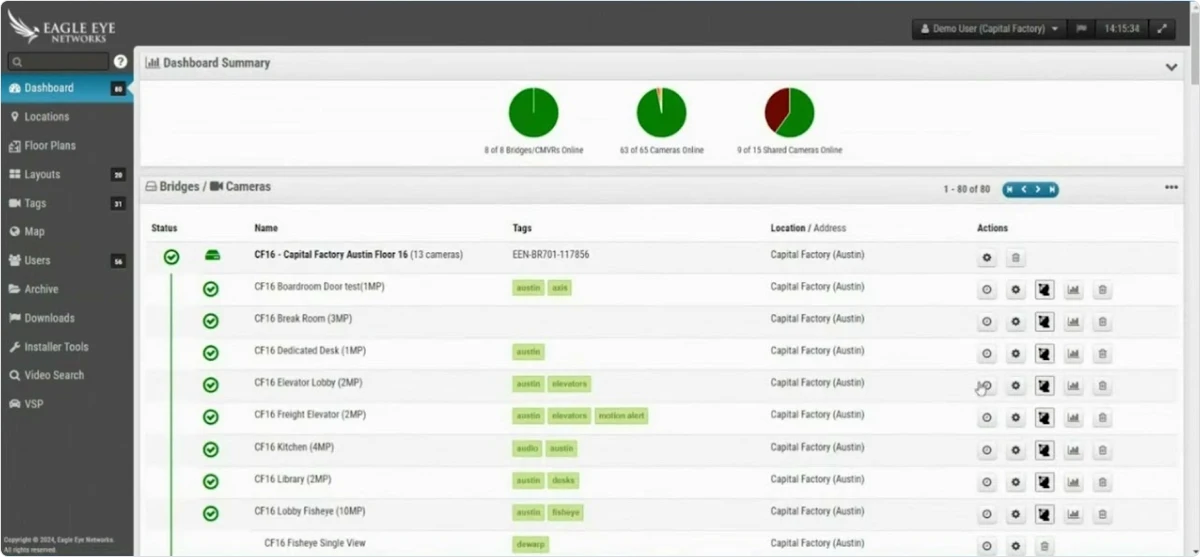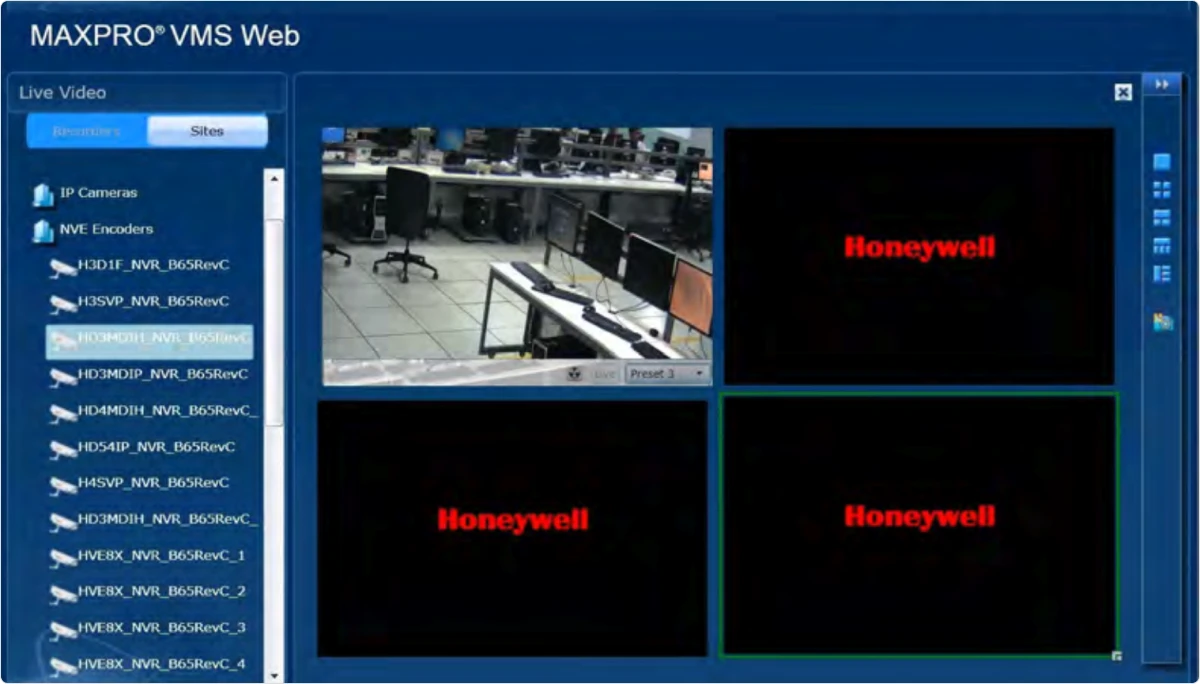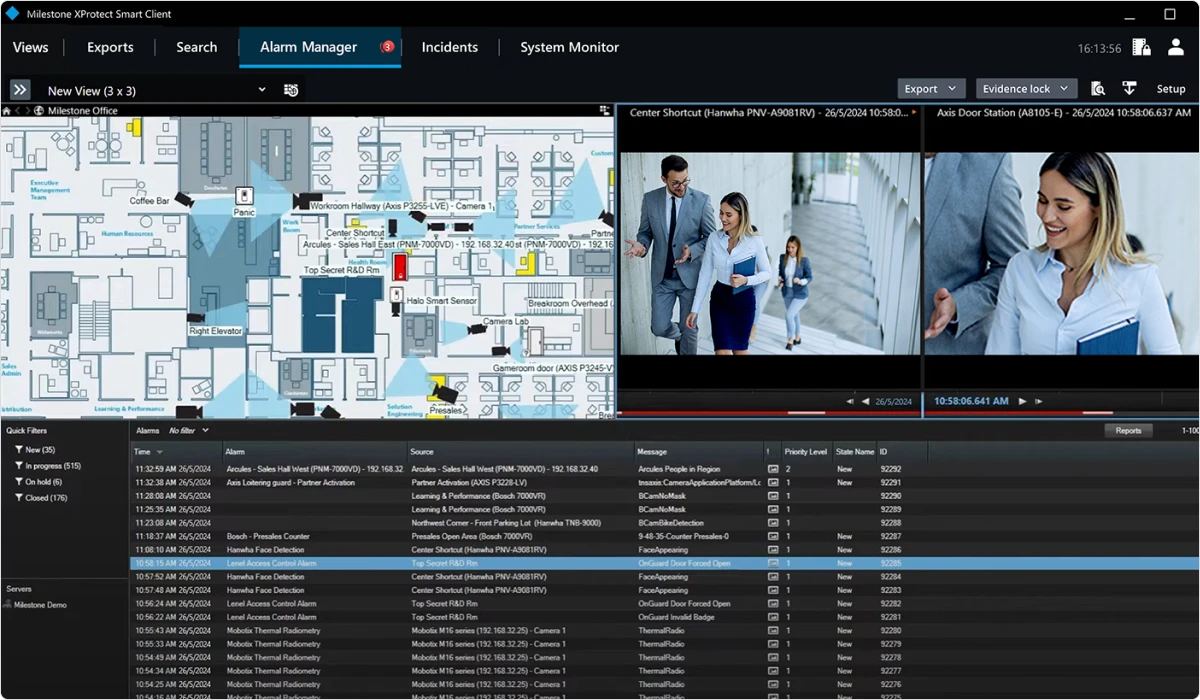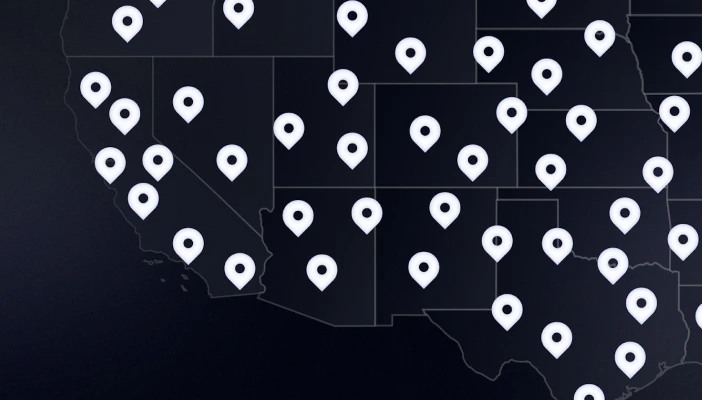Video analytics software leverages AI and computer vision to enhance security, enabling real-time threat detection, facial and vehicle recognition, and instant alerts. These customizable platforms offer robust data protection and seamless integration, safeguarding people and assets across various environments.
This guide highlights top video analytics solutions for 2025, comparing their key capabilities.
What Is Video Analytics Software?
Video analytics software is a technology that uses artificial intelligence (AI) and machine learning algorithms to process and analyze video footage. It extracts meaningful information from video data without human intervention, turning unstructured video data into structured data that can be searched, analyzed, and acted upon.
This software is often used in security and surveillance systems, where it can detect specific actions or behaviors, like trespassing or loitering, and send alerts to operators. It can identify and track objects, people, or patterns within the video, enabling real-time threat detection and quicker response to incidents.
Beyond security, video analytics software also has applications in various other fields. In retail, for example, it can be used to track customer behavior and movement, providing valuable insights about store layouts, product placements, and promotional effectiveness. In traffic management, it can monitor cars and pedestrian movement to improve traffic flow and pedestrian safety.
Video analytics software is a powerful tool that revolutionizes the utilization of video footage, delivering actionable insights and enabling swift, informed decision-making.
What Features and Functions Should You Look For In Video Analytics Software?
When choosing video analytics software, you should look for the following features and functions:
- Real-Time Analysis: The software should be able to analyze video streams in real time to identify and alert security personnel to potential threats.
- Object Recognition: The software should be able to identify and track specific objects across multiple frames, which is useful in identifying specific individuals or vehicles.
- Facial Recognition: This technological feature is crucial for identifying individuals, particularly in law enforcement settings or for access control in secure areas.
- Intrusion Detection: The ability to detect movement in and out of specific areas to improve perimeter security.
- Abnormal Behavior Detection: Using machine learning and AI, the software should be able to identify and alert you to unusual or abnormal behavior.
- Safety Features: This includes the identification of events related to threats, violence, missing PPE, fire, messy workstations, improper use of forklifts, and other safety hazards.
- Crowding and Loitering Detection: The ability to identify and monitor large groups of people and individuals who are present in an area for longer than the typical duration can be critical in preventing potential security incidents.
- License Plate Recognition: This feature can be used for vehicle access control, traffic enforcement, and parking management.
- AI-Powered Insights: The software should provide actionable insights derived from analyzed video data to support informed decision-making.
- Easy to Integrate: The software should be compatible with your existing camera system for easy integration.
- User-Friendly Interface: The software platform should be intuitive and easy to navigate, featuring real-time video feeds, analytics dashboards, alerts, and other key functionalities.
- Scalability: Whether you plan to expand your camera network or incorporate high-resolution cameras, you need software that adjusts accordingly.
- Robust Security: Ensure that the software has strong data encryption and privacy features to protect sensitive data.
- Customizable: The software should be customizable to meet your organization’s unique requirements.
- Cloud-Based Access: Having a cloud-based option allows remote access from anywhere, making monitoring and managing security data more flexible.
- Support and Training: Look for vendors that provide thorough training and ongoing technical support.
It is vital to ensure the video analytics software you choose has these crucial features to maximize its effectiveness for your organization.
The Key Benefits of Video Analytics Software
Video analytics software is revolutionizing the security industry by transforming traditional surveillance into intelligent, proactive protection. Businesses benefit from video analytics software in the following ways:
Improved Security: Video analytics software can recognize suspicious activity and alert security teams in real-time, thereby enhancing security monitoring and response times.
Operational Efficiency: By automating the surveillance process, video analytics software eliminates the need for constant human monitoring, resulting in cost savings and enhanced efficiency.
Enhanced Decision Making: The software provides valuable insights from video data that can aid in decision-making for businesses. For instance, it can provide customer behavior data in retail environments or monitor and optimize factory assembly lines.
Real-time Alerts: Video analytics can generate real-time alerts in response to predefined events or anomalies, ensuring immediate response to potential incidents.
Scalability: It can handle vast volumes of video data across multiple cameras and locations, providing an easily scalable solution for large or growing operations.
Cost Savings: It reduces the need for manual monitoring and helps identify inefficiencies or issues quickly, thereby reducing operational costs.
Improved Customer Experience: In retail, for example, video analytics can track customer movements, helping retailers to optimize store layout and increase customer satisfaction.
Predictive Analysis: Advanced video analytics solutions can analyze patterns and trends over time, providing predictive insights that enable the anticipation and preparation for future events or behaviors.
Compliance and Auditing: The software can provide visual evidence and insights necessary to meet specific regulatory compliance requirements or for auditing purposes.
Time Savings: The automated analysis of video content saves a significant amount of time compared to manual processing, freeing up staff for other tasks.
The Top Video Analytics Software Solutions
1. Lumana

Lumana stands out for its real-time AI-powered security, centralized management, and seamless integration with existing infrastructure. It helps organizations proactively manage security across multiple sites, streamline operations, and accelerate investigations.
Lumana delivers powerful AI-driven video analytics across various industries, including campus safety, retail, public spaces, healthcare, and logistics.
But deployments require robust internet connectivity, upfront infrastructure, and thoughtful configuration to unlock full value. Here’s a breakdown of Lumana’s key features, pros, and cons.
Top Use Cases:
1. Real-Time Incident Detection and Response
Instantly identifies suspicious activity, unauthorized access, or safety violations using AI-driven alerts. Consequently, it enables teams to respond to incidents as they happen, minimizing risk and potential damage.
2. Advanced Video Search and Investigation
Smart search tools allow users to locate specific footage across millions of hours of video in seconds, streamlining investigations and evidence gathering.
3. Operational Efficiency and Quality Control
Offers actionable insights into people traffic, space utilization, and operational trends, helping businesses optimize workflows and improve accountability.
4. Multi-Site Security Monitoring
Centralizes video feeds from unlimited cameras and locations, allowing organizations to oversee security operations from a single dashboard—ideal for growing businesses or enterprises with multiple sites.
5. Seamless Integration with Existing Infrastructure
Enhances current camera systems with AI capabilities, eliminating the need for costly hardware replacements and making upgrades fast and minimally disruptive.
6. Best-in-class AI Dashboard
Lumana's AI dashboard empowers you to turn video footage into actionable operational insights. Capturing live data from video enhances visibility and scale, while fostering smarter decision-making.
Pros:
Self-Learning AI
The model adapts over time, reducing false alarms and fine-tuning itself to your environment.
Camera-Agnostic & Scalable
Works with any IP camera and scales via a hybrid cloud architecture, supporting an unlimited number of devices and users.
Edge+Cloud Design
Lumana Core processes events locally, then syncs intelligently, increasing speed and reliability. Lumana’s cloud platform also facilitates video security at scale by allowing users to manage sites remotely. It offers easy accessibility with its intuitive, user-friendly mobile and web browser application.
Unified Management Platform
Lumana’s centralized system management liberates users with its simplicity, enabling them to manage all cameras and locations, find detailed footage in seconds, and detect meaningful events in real-time. Furthermore, it streamlines user management, allowing organizations to manage users and roles with granular permissions from a single interface. Efficiency is also improved due to its unified platform, which eliminates the need for manual monitoring and physical travel between locations.
Tailored Functionality
Lumana is nimble, capable of providing industry-specific solutions across various sectors, including retail, government, education, manufacturing, hospitality, and healthcare.
Cons:
Internet Reliance
Cloud-based management and hybrid sync rely on stable connectivity. Therefore, interruption may limit access.
Initial Investment & Learning Curve
Setting up edge hardware (Core device) and AI may involve upfront expenses and technical training.
Feature Depth
Some advanced triggers (like nuanced behavior detection) may require custom configurations, and early adopters might encounter setup complexity.
Lumana’s top use cases merit a comprehensive discussion. So, we took a more in-depth look at its enterprise video security analytics features in a separate section.
2. Avigilon

Avigilon video analytics excels in enterprise-grade environments requiring high-adrenaline detection, forensics, and License Plate Recognition (LPR)—all wrapped into a secure, scalable ecosystem. It’s a powerful tool for security-first agendas, but it comes at a premium cost, with tighter hardware compatibility and a learning curve in deployment.
Top Use Case:
1. Smart Surveillance & Real-Time Alerts
Facial recognition and object detection in security and surveillance. Embedded self-learning analytics detect people, vehicles, and unusual behavior, minimizing false alarms and ensuring security teams focus on what matters.
2. Forensic Investigation
Appearance Search enables users to locate individuals or vehicles across hours of footage quickly, utilizing descriptions, face recognition, or clothing details for expedited incident review.
3. Operational Insights
AI-enabled analytics, such as occupancy counting and idle scene detection, streamline facility management and operational workflows.
4. License Plate Recognition (LPR)
VehicleManager Enterprise supports vehicle tracking, watch lists, route mapping, and automatic entry alerts, making it ideal for parking enforcement and access control.
Pros:
Self-Learning Analytics
Automatically calibrates to the environment, reducing false alarms over time.
Powerful Searches
Deep learning enables appearance-based searches across multiple sites for efficient investigations.
Edge-based Intelligence
Analytics run directly on high-res cameras (up to 5K), reducing server load and cost.
Unified Platform
Seamless integration with Avigilon Control Center (ACC) and mobile access for unified monitoring and alerting.
Scalable & Flexible
Cloud‑ready or on‑prem deployments with hybrid architecture, supporting multi-site setups.
Effective Stream Management
Provides high-definition stream management, obtaining clear image details. It's efficient in bandwidth and storage usage.
Cons:
Proprietary Camera Bias
Analytics perform best on Avigilon cameras. Support for third-party devices, even ONVIF‑compatible ones, may be uneven.
Steep Cost
Enterprise-grade pricing, recurring licensing fees, and bundled hardware can be a significant investment.
UI & Setup Complexity
While analytics are robust, the interface can feel dated and complex for new users. Moreover, setup requires expertise—consider a “try before you buy” approach for integrations.
3. Eagle Eye Networks

Eagle Eye Networks delivers cloud-first surveillance with powerful AI and integration flexibility—ideal for multi-site businesses seeking centralized monitoring and smart analytics. However, ongoing subscription costs, reliance on a stable internet connection, and potential latency are critical considerations.
However, for operations with reliable connectivity and a need for scalable intelligence, it’s a compelling option—especially when repurposing existing cameras. For those with tight budgets or inconsistent connectivity, hybrid or local-first alternatives may be more practical.
Top Use Case:
1. Multi-Site Cloud Surveillance
Centralized live monitoring for businesses with multiple locations, accessible anytime via web or mobile.
2. Retail & Operational Intelligence
AI-driven analytics, such as object counting, loitering detection, and line crossing, reveal retail patterns and security threats, providing valuable insights for retailers and security personnel.
3. License Plate Recognition (LPR)
Add-on LPR features support parking management, vehicle access, and automated alerts.
4. Secure & Scalable Infrastructure
Fully encrypted, open-API cloud VMS that grows with your organization—ideal for IT-driven teams.
Pros:
No Local NVR Required
Fully cloud-based VMS eliminates hardware costs and simplifies scaling.
Supports Legacy Cameras
The Bridge appliance enables the use of existing IP or analog cameras, saving CAPEX.
Robust AI Analytics
Includes intrusion, loitering, object counting, tampering detection, and optional LPR.
Remote Access Anywhere
Live and recorded feeds can be accessed at any time from the web or mobile apps.
Open API Integrations
Easily connects with access control, POS, sensors, alarms, and other enterprise systems.
Cons:
Ongoing Subscription Fees
Cloud storage and analytics are billed per camera; costs can escalate over time.
Internet-Dependent Performance
Requires stable connectivity; users have reported slow playback and latency in some cases.
Limited Local Backup
The bridge device offers some buffering, but comprehensive offline recording still requires an external setup.
AI False Positives
Some analytics, particularly motion detection, can generate false alerts unless carefully tuned.
4. Honeywell Video Analytics

Honeywell Video Analytics is a strong fit for health and safety-focused spaces, such as hospitals, workplaces, and public venues, where enforcing health protocols is crucial. It’s powerful in occupancy and flow tracking, especially when integrated with MAXPRO or Pro-Watch ecosystems.
However, if you're looking for diverse analytics across multi-vendor cameras or a more modern UX, you may find more flexible alternatives elsewhere.
Top Use Case:
1. Health & Safety Compliance
Monitors mask usage and enforces social distancing in real time—ideal for facilities adhering to public health protocols.
2. Occupancy & Flow Monitoring
Tracks people and vehicles entering or exiting zones, and measures dwell times—useful for retail, facilities management, and space optimization.
3. Traffic & Parking Management
Leverages license plate recognition and flow analytics to manage vehicle movement—perfect for airports, campuses, and parking facilities.
4. Security
Perimeter protection, motion detection, and intrusion detection for security and defense.
Pros:
Strong Accuracy
Delivers >80% accuracy in mask and distance detection under optimal conditions.
Leverages Existing Cameras
Can run on current infrastructure, reducing hardware refresh costs.
Robust Insight Capabilities
Offers real-time counting, dwell-time analytics, and custom incident reporting for better space and flow management.
Enterprise Integration
Built into Honeywell MAXPRO and Pro-Watch platforms for unified building and security management.
Cons:
Dependent on Camera Quality
Accuracy drops if cameras aren’t positioned or configured per Honeywell’s guidelines. Additionally, the system may generate false alarms under certain lighting conditions.
Vendor Lock-In
Works best within Honeywell ecosystems—ONVIF or third-party camera support may be inconsistent.
Interface Limitations
User experience can feel dated and may require specialized setup expertise.
Niche Use Cases
Primarily focused on mask compliance and social distancing—less versatile for broad analytics needs.
5. Milestone XProtect

Milestone XProtect delivers unmatched scalability, integration potential, and enterprise-grade security, making it a go-to solution for global campuses, critical infrastructure, and complex security environments.
But this power comes at a cost: steep hardware requirements, licensing complexity, and a deep technical curve. If your operation requires a full-scale VMS with extensibility and mission-critical performance, and has the resources to deploy it, XProtect stands out. However, for leaner operations with lighter needs, considering alternatives might save you time, budget, and bandwidth.
Top Use Case:
1. Enterprise Surveillance & Situational Awareness
Centralized surveillance and security across multiple sites or locations. Moreover, it scales from small sites to multi-location deployments across thousands of cameras, centralizing monitoring via live feeds, smart walls, and GIS/CAD mapping.
2. Advanced Forensic Investigation
Integrates with analytics like BriefCam and LPR. Rapid REVIEW and embedded search tools help operators pinpoint people, vehicles, or events in seconds.
3. Access Control & Alarm Integration
Fully open-platform: connects to intrusion sensors, fire alarms, access systems, and IoT devices, triggering video capture and real-time alerts.
Pros:
Truly Open-Platform
Supports >14,000 devices—including legacy cameras—without vendor lock-in. Mix and match tools freely.
Scalable & Flexible Architecture
From Essential (8 cameras) to Corporate (mission-critical infrastructures), it scales with failover, interconnect, and centralized management. Offers seamless hardware integration and high reliability.
Deep Enterprise Security
Built-in compliance, encryption, role-based access, audit logging, and integration with cybersecurity standards.
Feature-Rich Extensions
From LPR and smart wall dashboards to incident reporting and POS integration, it is extensible to meet evolving use cases.
Cons:
Steep Learning Curve
Advanced features bring complexity. Initial setup and multi-client architecture demand deep technical skill.
Resource Hungry
Demands powerful Windows servers, SQL backends, GPUs for H.265 decoding—significant hardware investment. Therefore, in addition to requiring a high learning curve, the system may be more expensive than other options.
Cost & Licensing Overhead
Licensing scales with camera count and server variants, potentially resulting in costly setups for smaller deployments.
UI Is Feature-Big But Dense
While powerful, the client interface can feel dated and heavy, especially for users without admin-level training.
6. Genetec
Genetec is a powerhouse for organizations that require a robust, unified security platform with deep analytics and flexible integration capabilities. It excels in high-security, complex environments such as cities, critical infrastructure, and large enterprises.
However, the trade-off comes in the form of cost, complexity, and resource demands, making it best suited for teams with the scale and expertise to manage it effectively.
Top Use Case:
1. City-Wide Surveillance / Smart Cities
Monitor traffic, public spaces, and infrastructure across urban areas. Integrates with multiple data sources (CCTV, IoT sensors, traffic systems) for a unified command view.
2. Enterprise Physical Security
Manage video surveillance, access control, and intrusion detection across multi-site organizations. Scales well across thousands of endpoints while offering granular policy control.
3. Critical Infrastructure Protection
Secures facilities like power plants, airports, seaports, and data centers. Facilitates automated perimeter monitoring, behavior analytics, and cybersecurity hardening.
4. Retail Security and Operations
Prevent theft, monitor store traffic, and analyze consumer behavior.
5. Education / Campus Safety
Protect students and faculty with real-time situational awareness across school campuses. It offers rapid response capabilities with real-time communication integration (e.g., intercom, SMS alerts).
Pros:
Unified Platform
Combines video surveillance, access control, ALPR, and communications in one dashboard.
Scalability
Handles small deployments to large, multi-site enterprises and city-wide systems.
Open Architecture
Integrates with third-party hardware and analytics providers (e.g., Axis, Bosch, BriefCam).
Cybersecurity-Focused
Built-in security features like encryption, secure boot, and certificate management.
Real-Time Intelligence
Advanced analytics engine for license plate recognition, facial matching, and incident detection.
Strong Ecosystem
Large partner and integrator network for customization and support.
Cons:
Cost
High initial investment; may not be ideal for small businesses or budget-sensitive deployments.
Complexity
Feature-rich, but requires skilled administrators to configure and manage effectively.
Hardware Requirements
May require specific or certified hardware for optimal performance, especially at scale.
Learning Curve
Its unified interface is powerful but can be overwhelming without proper training.
Limited Cloud Capabilities
Although Genetec is a cloud-connected solution, its cloud performance falls short, particularly when compared to other video analytic solutions with more robust cloud-native capabilities.
7. Axis Communications

Axis Communications excels in delivering reliable, secure, and high-performance camera hardware with solid onboard analytics. Its strength lies in flexible deployment across industries—from retail to critical infrastructure—especially where edge analytics and image quality matter.
However, Axis is hardware-focused, so unlocking its full potential often requires pairing with a third-party VMS or analytics platform. Ideal for organizations that value flexibility, scalability, and strong device-level security.
Top Use Case:
1. Retail Security and Operations
Prevent theft, reduce shrinkage, and gain customer insights. To achieve this, Axis leverages people counting, heat mapping, dwell time analytics, and POS integration.
2. Critical Infrastructure Protection
Monitor sensitive sites, such as power plants, water facilities, and transportation hubs. Its durable, weather-resistant cameras with built-in analytics are ideal for 24/7 outdoor monitoring.
3. Smart Cities
Enhance public safety and traffic management. Ideal for license plate recognition, vehicle classification, crowd detection, and traffic analytics. Axis cameras deliver reliable performance across variable environments and integrate with city management platforms.
4. Manufacturing and Industry
Improve safety and efficiency on factory floors and warehouses. Axis’ ruggedized cameras can withstand harsh environments while their edge processing reduces latency. It also facilitates hazard detection, worker safety compliance, line monitoring, and process visualization.
5. Education and Campus Security
Monitor hallways, entrances, and common areas for safety threats or incidents. Audio detection (aggression or glass breaking), access control integration, and real-time alerts.
Pros:
Edge-Based Analytics
Many cameras process data locally, reducing server load and bandwidth use.
Hardware Variety
Extensive portfolio—PTZ, thermal, panoramic, dome, and body-worn cameras for all environments.
Cybersecurity-First Design
Secure boot, signed firmware, and regular security updates.
Open API & ONVIF Compliance
Seamless integration with third-party VMS and analytics platforms.
Excellent Image Quality
Industry-leading resolution, low-light performance, and WDR (Wide Dynamic Range).
Scalability
Suitable for everything from single-location setups to global multi-site deployments.
Cons:
Upfront Cost
Premium hardware with a higher initial price point than many competitors.
Analytics Limitations
On-camera analytics are solid but not as advanced as full AI-powered platforms.
No Native VMS
Axis doesn’t offer a fully featured native VMS—typically requires integration with platforms like Milestone or Genetec.
Requires Integration for Full Functionality
Advanced use cases often depend on third-party software or custom integration.
Edge Storage Limitations
While edge analytics reduces server reliance, local storage capacity may still be a constraint for high-resolution, long-duration footage.
Why Organizations Use Lumana for Enterprise Video Analytics (And How It Is Better Than Other Systems)
Lumana is an advanced video analytics platform purpose-built for enterprise security environments. It stands out by combining real-time intelligence, AI-powered automation, and intuitive scalability, delivering unmatched situational awareness and response capabilities.
Key Ways Lumana Enhances Enterprise Security and Operations:
1. Real-Time Threat Detection and Alerting
Lumana utilizes edge-based AI algorithms to detect intrusions, suspicious behavior, unauthorized access, and loitering in real-time. Unlike traditional systems that require human review, Lumana automates alerts, pushing notifications directly to command centers, mobile devices, or third-party systems, ensuring immediate response.
2. Multi-Layered Object & Behavior Recognition
Its sophisticated object recognition engine can track people, vehicles, and objects across cameras and locations. However, Lumana goes beyond basic detection by understanding contextual behavior, identifying not just who or what is present, but why it matters based on defined security policies.
3. Seamless Integration with Existing Infrastructure
Designed to work with a wide range of IP cameras and VMS platforms, Lumana integrates easily into enterprise ecosystems. There's no need for a full hardware overhaul, making deployment faster and more cost-efficient.
4. Scalable Cloud and Hybrid Architecture
Lumana supports both cloud-based and hybrid deployments, allowing enterprises to scale across multiple sites with centralized analytics and edge processing. This flexibility ensures performance without compromising security or latency.
5. Intuitive Dashboard and Reporting
It allows organizations to turn video data into actionable insights through AI-powered dashboards. Organizations can customize dashboards to monitor activity and trends at scale, such as security alerts, occupancy, safety violations, and more.
6. Enterprise-Grade Data Security and Privacy
With end-to-end encryption, role-based access, and GDPR-compliant data management, Lumana prioritizes privacy and security, which are critical for sensitive enterprise environments.
By leveraging advanced video analytics, Lumana provides detailed insights into activities and movements within and around a facility, enabling the detection of suspicious behaviors that may indicate security breaches or potential operational issues.
Schedule a demo with us today to learn more about the power of AI video security.
Looking for the best video analytics solution?
Related Articles
Security infrastructure
Dec 18, 2025
The Benefits of Unifying AI Video Security and Access Control
Company
Dec 15, 2025
Lumana Surpasses 50,000 Cameras, Cementing Its Leadership in AI Video Surveillance
Product
Dec 5, 2025








